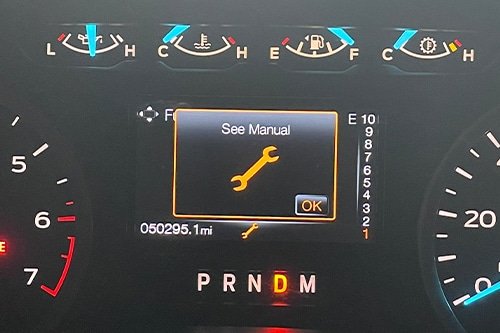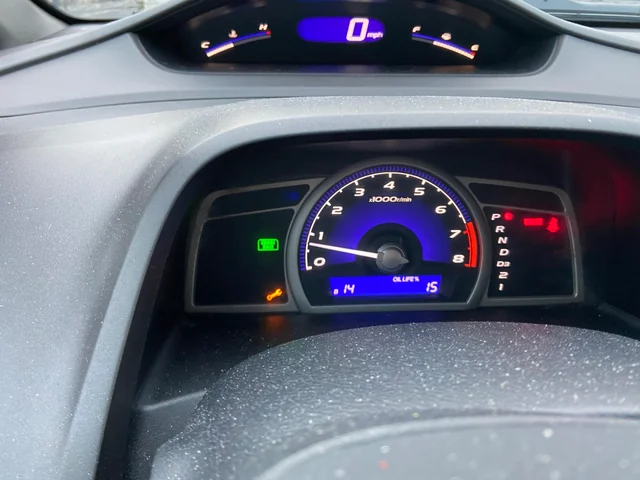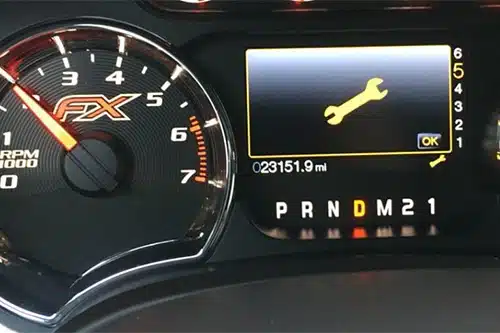A wrench on the dashboard means there’s a maintenance issue with your vehicle. It often signals the need for a service check.
Seeing a wrench icon on your dashboard can be alarming. This indicator typically signifies that your vehicle requires maintenance. It could be a routine service like an oil change or a more critical issue. Ignoring this warning might lead to more significant problems.
Regular maintenance is crucial for your vehicle’s longevity and performance. If the wrench light appears, consult your owner’s manual. It will provide specific guidance related to your vehicle model. Taking prompt action can save you from costly repairs.
Always ensure your car is in top condition to avoid unexpected breakdowns. Regular check-ups can keep your vehicle running smoothly.

Credit: branchautomotive.com
Common Dashboard Symbols
Your car’s dashboard is like a communication center. It tells you how your car feels. Understanding the symbols can save you time and money. One of these symbols is a wrench. But what does it mean? Let’s explore common dashboard symbols to find out.
Warning Lights
Warning lights alert you to serious issues. They often require immediate attention. Here are some common warning lights:
- Check Engine Light: Signals engine problems.
- Battery Light: Indicates battery or charging issues.
- Oil Pressure Light: Alerts low oil pressure.
- Brake Warning Light: Shows brake system issues.
These lights are usually red or orange. They mean something needs fixing soon.
Indicator Lights
Indicator lights give information about your car’s status. They are generally less urgent than warning lights. Common indicator lights include:
- Turn Signal Light: Shows you are about to turn.
- High Beam Light: Indicates high beam headlights are on.
- Seatbelt Light: Reminds you to buckle up.
- Low Fuel Light: Alerts you to low fuel levels.
These lights are usually green or blue. They keep you informed but don’t require immediate action.
Wrench Light
The wrench light is a bit different. It often means your car needs maintenance. This could be an oil change or a service check. It’s not an emergency, but don’t ignore it.
| Light | Color | Action Required |
|---|---|---|
| Check Engine | Red/Orange | Immediate |
| Battery | Red | Immediate |
| Oil Pressure | Red | Immediate |
| Brake Warning | Red | Immediate |
| Turn Signal | Green | Informative |
| High Beam | Blue | Informative |
| Seatbelt | Red | Informative |
| Low Fuel | Yellow | Informative |
| Wrench | Yellow | Maintenance |
Understanding these symbols can help you maintain your car better. Always pay attention to your dashboard. It is your car’s way of talking to you.
Wrench Symbol Meaning
Seeing a wrench symbol on your car’s dashboard can be confusing. This symbol often indicates a need for maintenance. It is important to understand what this symbol means to avoid issues.

Credit: www.thedrive.com
Maintenance Reminder
The wrench symbol is often a maintenance reminder. It suggests that your vehicle needs a routine check-up. This could involve changing the oil, rotating the tires, or inspecting the brakes.
| Maintenance Task | Frequency |
|---|---|
| Oil Change | Every 3,000-5,000 miles |
| Tire Rotation | Every 6,000-8,000 miles |
| Brake Inspection | Every 10,000 miles |
Service Required
Sometimes, the wrench symbol means service is required. This could be due to an underlying issue. Examples include engine problems, transmission issues, or electrical faults.
- Engine Problems: Check engine light might also be on.
- Transmission Issues: You may feel jerking or slipping while driving.
- Electrical Faults: Lights or other electronics may malfunction.
Consult your vehicle’s manual to understand the exact meaning. Ignoring the wrench symbol can lead to bigger problems.
Other Critical Alerts
When you see a wrench on your dashboard, it’s not the only alert to watch out for. Your car’s dashboard can display several important warnings that require immediate attention. Understanding these alerts helps keep your vehicle in good condition and ensures your safety on the road.
Check Engine Light
The Check Engine Light is one of the most critical alerts. It can indicate several issues, ranging from a loose gas cap to more severe engine problems.
- A steady light means a minor issue.
- A flashing light means a serious problem.
If the light is flashing, it’s best to stop driving immediately and seek professional help. Regular maintenance can often prevent this light from appearing.
Battery Warning
The Battery Warning light indicates a problem with the car’s electrical system. This light usually looks like a battery symbol.
Possible reasons for this alert include:
- Aging battery
- Faulty alternator
- Loose or corroded connections
If this light comes on, check the battery and its connections. If the problem persists, consult a mechanic.
| Warning Light | Possible Issues | Action Required |
|---|---|---|
| Check Engine Light | Engine issues, gas cap, exhaust problems | Consult mechanic, regular maintenance |
| Battery Warning | Aging battery, alternator, connections | Check battery, consult mechanic |
These alerts are vital for maintaining your car’s health. Always pay attention and act promptly.
Interpreting Color Codes
Understanding the color codes on your dashboard is essential for safe driving. The wrench symbol indicates different types of alerts, each with its own color code. These colors help you quickly understand the urgency of the issue.
Red Alerts
Red alerts are the most critical. When you see a red wrench on your dashboard, stop your car immediately. This color indicates a severe problem that needs urgent attention. It could mean a major issue with your engine or transmission. Ignoring a red alert can lead to costly repairs or even accidents.
- Engine overheating
- Transmission failure
- Brake system malfunction
If you encounter any of these issues, contact a professional mechanic right away.
Yellow Alerts
Yellow alerts are less urgent but still important. A yellow wrench usually means there is a minor issue that needs attention soon. This could be a signal for routine maintenance or a minor part that needs replacement.
- Oil change needed
- Low tire pressure
- Battery check required
Address these issues at your earliest convenience to keep your car running smoothly.
| Alert Color | Urgency | Examples |
|---|---|---|
| Red | High | Engine overheating, Transmission failure |
| Yellow | Medium | Oil change, Low tire pressure |
Steps To Take When Wrench Symbol Appears
When the wrench symbol appears on your dashboard, it signals a need for attention. This icon usually means there’s a problem with your vehicle’s maintenance or a specific system. Knowing the steps to take when this icon lights up can help you address issues promptly.
Immediate Actions
When you see the wrench symbol, take these immediate actions:
- Check the owner’s manual for specific details about the symbol.
- Inspect fluid levels, including oil, coolant, and transmission fluid.
- Listen for unusual noises that might indicate a problem.
- Drive cautiously to avoid further damage until the issue is fixed.
Scheduled Maintenance
Regular maintenance can prevent the wrench symbol from appearing. Follow these scheduled maintenance steps:
- Oil Changes: Change your oil every 3,000 to 5,000 miles.
- Fluid Checks: Regularly check and top off all vehicle fluids.
- Tire Rotation: Rotate your tires every 6,000 to 8,000 miles.
- Brake Inspection: Inspect brakes every 12,000 miles or as needed.
| Maintenance Task | Frequency |
|---|---|
| Oil Change | Every 3,000 to 5,000 miles |
| Fluid Check | Monthly |
| Tire Rotation | Every 6,000 to 8,000 miles |
| Brake Inspection | Every 12,000 miles |
Following these steps ensures your vehicle stays in good condition. It also helps you avoid unexpected issues on the road.

Credit: www.reddit.com
Consulting Your Vehicle’s Manual
Seeing a wrench on your dashboard can be confusing. Your vehicle’s manual can help you understand what it means. This guide explains how to find the right information in your manual.
Finding Information
Your vehicle’s manual is a valuable resource. It contains crucial details about your car. To find information quickly, use the table of contents or index. These sections list where to find specific topics.
| Section | Content |
|---|---|
| Table of Contents | Lists chapters and main sections |
| Index | Provides detailed topic listings |
Common Manual Sections
Manuals typically have several key sections. These sections cover various aspects of your vehicle. Here are some common sections you might find:
- Introduction: Overview of the manual and vehicle
- Dashboard Symbols: Explanation of dashboard icons
- Maintenance: Guides on regular vehicle upkeep
- Troubleshooting: Solutions for common issues
- Specifications: Technical details about the car
The Dashboard Symbols section is particularly useful. It explains what each symbol means, including the wrench icon. This helps you understand if your car needs maintenance.
When To Visit A Mechanic
When you see a wrench icon on your dashboard, it means your car needs attention. This could range from minor maintenance to major repairs. Knowing when to visit a mechanic can save you from bigger problems down the road.
Urgent Situations
In certain cases, the wrench icon signals urgent issues. You should see a mechanic immediately if:
- Your car stalls frequently
- Strange noises come from the engine
- You notice fluid leaks under your car
These situations can lead to serious damage. Address them quickly to avoid costly repairs.
Routine Visits
Routine maintenance is crucial for your car’s health. The wrench icon might remind you of:
- Oil changes
- Brake inspections
- Tire rotations
Staying on top of these tasks ensures your car runs smoothly. It can also extend the life of your vehicle.
Here’s a simple table to remember the common service intervals:
| Service | Mileage |
|---|---|
| Oil Change | Every 3,000 – 5,000 miles |
| Brake Inspection | Every 10,000 miles |
| Tire Rotation | Every 6,000 miles |
Following these guidelines can keep your car in top shape. The wrench icon will serve as a helpful reminder.

Credit: branchautomotive.com
Preventive Measures
Seeing a wrench on your dashboard can be alarming. It often signals a need for maintenance. Understanding preventive measures can help avoid serious issues. Regular checks and simple DIY tasks can keep your car healthy.
Regular Check-ups
Regular check-ups are crucial for your car’s health. Schedule visits to your mechanic every six months. These visits can catch problems early. A professional can spot issues you might miss. Keeping a maintenance log can also help. Write down each service and repair. This log helps track your car’s history. It can also aid in diagnosing future problems.
Diy Maintenance Tips
Some maintenance tasks are easy to do yourself. Here are a few tips:
- Check and change your oil. Fresh oil keeps the engine running smoothly.
- Inspect your tires. Look for wear and tear. Keep them inflated correctly.
- Replace air filters. Clean air filters improve engine performance.
- Monitor fluid levels. Check coolant, brake fluid, and transmission fluid.
- Test your battery. Ensure it has a good charge. Clean any corrosion on the terminals.
| Task | Frequency |
|---|---|
| Oil Change | Every 3,000-5,000 miles |
| Tire Inspection | Monthly |
| Air Filter Replacement | Every 12,000 miles |
| Fluid Level Check | Monthly |
| Battery Test | Every 6 months |
These tasks can keep your car in top shape. They also help avoid the wrench warning on your dashboard.
Frequently Asked Questions
- What Does A Wrench Light Mean?
A wrench light indicates a problem with your vehicle’s powertrain or maintenance schedule.
- Can I Drive With The Wrench Light On?
It’s not recommended. Driving with the wrench light on can cause further damage to your vehicle.
- How Do I Fix The Wrench Light?
Consult your vehicle’s manual or a mechanic. They can diagnose and fix the underlying issue.
- Is The Wrench Light Serious?
Yes, it can indicate serious issues. Immediate attention is required to avoid further damage.
- Does The Wrench Light Reset Itself?
No, it usually needs manual resetting after the issue is resolved by a professional.
Conclusion
Understanding the wrench icon on your dashboard is crucial. It signifies potential issues with your vehicle. Addressing these warnings promptly ensures your car runs smoothly.
Regular maintenance checks can prevent long-term damage. Always consult your vehicle’s manual for specific guidance.
Keeping your vehicle in top shape guarantees safety and reliability on the road.
Recent Posts
Maintaining clean gutters is essential for preventing water damage to your home, and choosing the best ladder for cleaning gutters can make the job much easier and safer. With so many options on the...
Best Ladder for Cleaning Caravan Roof: Top Picks for You Every Adventure!
Today we will discuss the best ladder for cleaning caravan roof. Cleaning caravan roofs is one of the crucial tasks.After many days, a caravan roof can get dirty by debris, dirt, and grime. These can...
